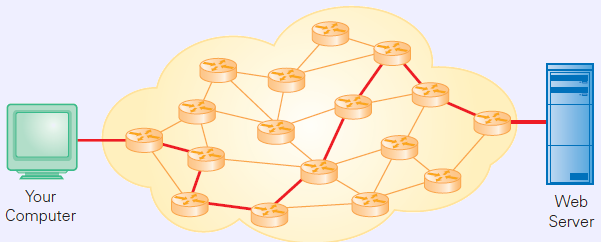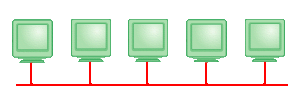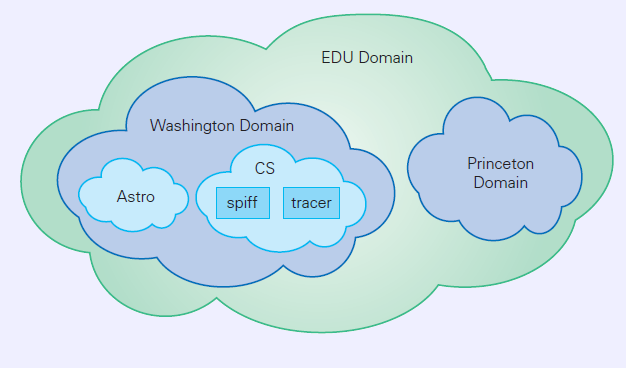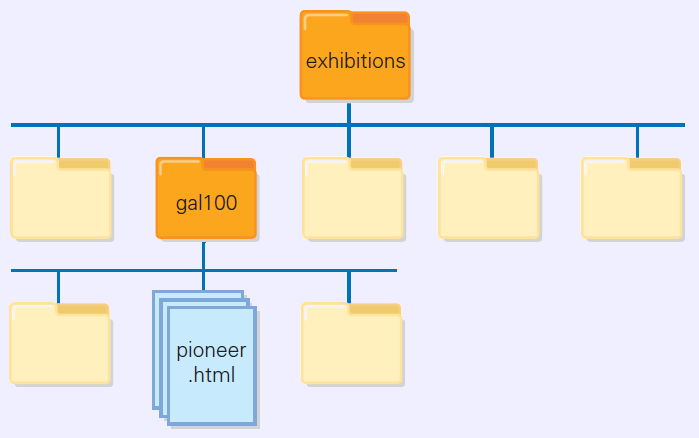- Communication types.
- Synchronous (interactive) v. asynchronous (message).
- Broadcast, multicast, point-to-point.
- Protocol.
- Rules both ends must follow to communicate correctly.
- Different classes of protocols govern different aspects of communication.
- Several can be in operation at once.
- Client and Server
- Client makes request.
- Server responds.
- Communication is over; server goes on to the next bit of work.
- No lengthy connection; just a series of exchanges.
- The web works this way.
- Simulating a long-term connection.
- Session information is recorded on the server, in a file or database.
- The browser records an identifier, which is sends with each request.
- Cookies or extended URLs.
- Division of labor.
- Work can be assigned to the client or server.
- Many tasks can be solved with various divisions.

- The Internet.
- Each machine has a numeric Internet Protocol Address
(IP address), e. g., 64.246.212.32.
Think: phone number - All messages are directed to destination by number.
- Interconnected computers.
- The net consists of links connected through routers.
- Each router forwards the message toward its destination. store-and-forward.
- Parts of a communication may take different paths.
- TCP/IP
- Two primary Internet protocols.
- Information broken into small parts: packets.
- Packets have sequence numbers.
- Each packet is sent separately; may take different routes.
- Packets reassembled at receiver.

- Each machine has a numeric Internet Protocol Address
(IP address), e. g., 64.246.212.32.
- LAN and WAN.
- Local Area Network (LAN).
- Connect within a building or small campus.
- All computers connected together.
- Each packet delivered to all.
- Share the channel.
- Ethernet is most common.
- Wait for quiet.
- Check for talking at once.
- If so, wait and try again.
- Wireless LANs
- Computers transmit packets by radio.
- Sharing protocol similar to Ethernet.
- A wireless hub.
- Transfers between wired and wireless.
- Forwards packets between clients.
- Wide Area Network (WAN).
- Covers a larger area.
- Generally store-and-forward, described above.
- Local Area Network (LAN).
- Connecting to the Internet.
- Large organizations: High-speed line to own LAN.
- Home: ISP.
- Dial-up modem.
- ADSL.
- Cable modem.
- Home networks are now common, most often mainly wireless.
- Cell phone connections, usually when traveling.

- Addresses and naming.
- Instead of sending messages by IP address, names are more convenient.
- Instead of everyone having a private “phone book” for IP addresses, there is a public one.
- Domain Name Service (DNS).
- Names are hierarchical.
- For example, www.mc.edu.
- Each section is a subdivision.
- Names are looked up by a series of servers for the levels.
- Historic top-level: .com, .edu, .org, .net, .mil, .gov.
- National domains: .ca, .de, .us, etc.
- Many more.
- Rules for creating new TLDs are looser now, but I don't see a lot of unfamiliar ones in practice.
- Here is the official list, but the Wikipedia has a more readable one.
- Rules for creating new TLDs are looser now, but I don't see a lot of unfamiliar ones in practice.

- The World-Wide Web.
- World-Wide Web is part of the Internet.
- Clients request files from servers; servers send them.
- Universal Resource Locator (URL):
http://www.mc.edu/campus/academics/CSC/
- Protocol, hostname, pathname. HTTP = Hypertext Transfer Protocol.
- Path is through folders to a file; must like a file path.
- The www is a convention.
- Redirection.
- Server answers, “Go look here instead”
- www.whatever often forwards to another server.
- Tiny-URL is a URL forwarding service. http://tinyurl.com/cqvah9x.
- Hypertext Markup Language (HTML).
- Text and tags.
- Images are in separate files; own URLs.
CSPAN interview
with Vint Cerf, one of the founders of the Internet.